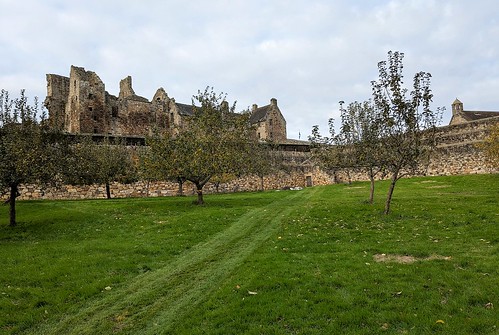Back in September Jack wanted to go to Dumbarton to watch a football match there, he’s a loyal supporter of Dumbarton Football Club – through thick and thin and at the moment it’s quite thin! Anyway, I’m not a huge football fan so I opted to visit Dumbarton Castle which is situated right at the football ground. As you can see below the info board names it Dun Breatann, Fortress of the Britons. Over the years the town which grew around the fort became known as Dumbarton, it’s a bit easier to say I suppose.
Although it’s called a castle it isn’t anything like Stirling or Edinburgh, but in its day it was one of the most important fortresses in Scotland. Ships sailed from here to France and elsewhere. Mary Queen of Scots sailed for France from the castle, she was also imprisoned here, and of course escaped. There have been lots of drawings of the area over the centuries and in some of them the patch of grass in the photo below has a house on it, it was demolished long ago. Behind the wall to the right are steps, when I was wee they used to say there was a step for every day of the year but now they say there are over 400. As a wee girl I tried to count them, but I always got a different tally.
And here are some of the steps in the photo below, these ones are right at the beginning and are possibly some of the steepest. It’s not a good place to visit if you aren’t good with stairs! On the other hand it will keep you fit.
The photo below is of a small part of the rock face. The whole thing is a volcanic plug.
At the moment some areas are cordoned off. The building below is known as the French Prison because during the Napoleonic wars it was used to house French prisoners, it’s apparently going to be refurbished and will then be open to the public, it never has been in my lifetime. The sunken area below with the metal bars in it is part of it too but is in much worse condition.
More rockiness!
There are still cannons in place. This has always been a very strategic place, at the confluence of the River Clyde and River Leven. The Romans were here, and the Vikings and it’s amazing how often it’s mentioned in historical fiction.
It was low tide at the River Clyde when I was there.
Below is a photo of some of the stairs seen from above. The small white building is a guard house and that hadn’t been open to the public before. Looking at this photo it strikes me that you need a head for heights!
Below is the River Clyde again. It’s a pity it was such a grey day as the views are spectacular when it’s bright.
Looking to the other side of the river in the photo below is a small part of the town, Dumbarton. I lived close to this area and it was my playground when I was a wee girl, but all of these houses and flats are new, sometimes the rivers pay them a visit! The Sunderland aircraft factory took up a lot of the land where these houses are now.
If you cast your mind back to when Prince Harry and Meghan Markle got married you might remember thet the Queen bestowed the Scottish title on them of Earl and Countess of Dumbarton on them. It was supposed to be an honour for the town I’m sure but they were unimpressed. It was expected that they would pay a visit to Dumbarton soon after they married as that’s what normally happens, but apparently (if you can believe the tabloids) the couple took it as an insult instead of the honour it was meant to be – something to do with the word ‘dumb’ apparently. Honestly, how daft can you get!

























